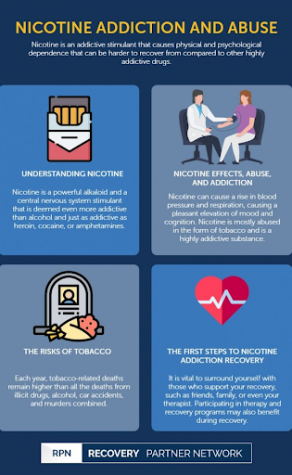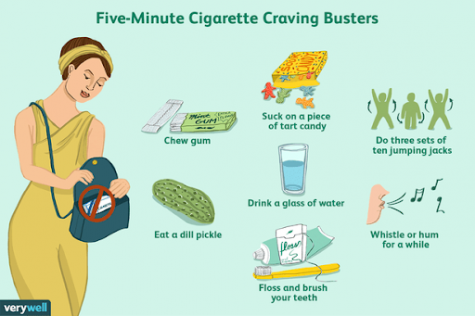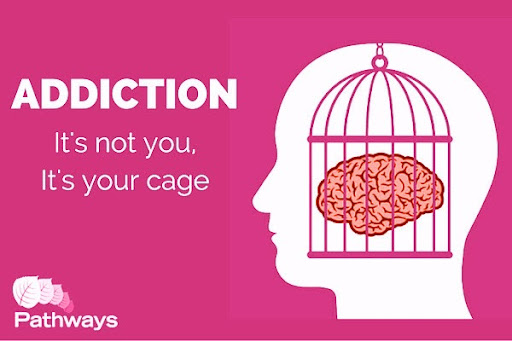Nicotine Addiction: What it is and How to Help
December 10, 2021
According to an article from americanaddictioncenters.org titled, “What is the Most Addictive Drug? Here are the Top 5”, more than 32M Americans aged 12 and older smoke on the daily. Nicotine is the 4th most addictive drug in America, and is extremely detrimental. Here are what students need to know about nicotine, and how they can help themselves and others from becoming addicted.
Founded in 1828, nicotine has affected many lives across the US. Nicotine is a toxin found in tobacco, founded by doctor Wilhelm Heinrich Posselt and chemist Karl Ludwig Reinmann. In the late 1840s, tobacco started to be sold in America. It was first sold by J.E. Liggett and Brother, an American company. At this time, many people chewed tobacco, but cigarettes then became popular in 1881 and were at the height of their popularity in the First and Second World War.

Tobacco has been proven to be a very harmful and addictive drug, so why do people smoke it? In an article from cancer.org titled, “Why People Start Using Tobacco, and Why It’s Hard to Stop,” most start smoking as teenagers. Some teens who start to smoke do it because it’s “cool” or they “just want to try it.” However, the tobacco industry itself is also to blame. When they advertise nicotine, they portray smoking as an exciting, safe activity when in reality it is damaging to one’s physical and mental health. Once an individual starts smoking, it is nearly impossible to stop. According to the 2014 Surgeon General’s Report (SGR), “…nearly 9 out of 10 adults who smoke started before age 18, and nearly all started by age 26. The report estimates that about 3 out of 4 high school students who smoke will become adults who smoke – even if they intend to quit in a few years,” as stated in the article.
Because nicotine is very addictive, it is extremely difficult to stop, but it is not impossible. If students are addicted to nicotine, there are many ways to start quitting nicotine. Call SAMHSA’s National Helpline at 1-800-662-HELP (4357) for support. If students are comfortable with telling their parents and asking for help, it is advised to do so. If not, “How Can I Quit Smoking? (for Teens)”, an article from kidshealth.org, suggests that teens write down their goals for quitting and their reasons for doing so. They also suggest getting support. If students are not comfortable telling their parents or guardians, that’s okay. Students can also confide in friends who they know will help and support them on this journey to sobriety. If they have unsupportive friends, it is recommended that students, “… join an online or in-person support group.”
There are some strategies in the article to help teens abandon nicotine. They include the following:
Setting a date: Nemours KidsHealth Suggests that teens who want to quit smoking set a date to when they want to quit. To help with this, they say to, “Think of the day as a dividing line between the smoking you and the new, improved nonsmoker you’ll become.”
Throwing away all products that contain nicotine: Though this seems obvious, it may be hard for some students to throw away their products and devices that contain nicotine. However, it is necessary in order to be fully sober. If necessary, students can ask their friends to dispose of the products for them.
Wash all clothes: This is suggested to people who are addicted to drugs such as nicotine. Students should wash all clothes that smell like their products that contain nicotine, whether it be vape pens, pod mods, or any type of smokeless tobacco. A persisting scent on clothes may tempt students to return to their previous habits, so ridding clothes of the smell can promote progress.

Think about the triggers: Teens are advised to think about when they have the urge to smoke. For instance, one may take a hit after they eat, or during 3rd period. The article states that, “Any situation where it feels automatic to have a cigarette is a trigger.” To break this cycle, students can replace smoking with something else. For example, if a teen regularly smokes after a meal, they can do something else (like going for a walk). An article from verywellmind.com titled, “101 Things to Do Instead of Smoking,” has a great list of what to replace smoking with to help students become sober.
Teens must remember that with sobriety comes withdrawal. When one tries to become sober, they are going to experience withdrawal symptoms which may make it challenging to continue their journey. Withdrawal is physical and mental symptoms that occur after stopping or reducing intake of a drug. Some of these symptoms, according to americanaddictioncenters.org, include insomnia, depression, irritability, nausea, vomiting, diarrhea, abdominal cramps, nightmares, muscle aches, back and joint pain, tremors, restlessness, cravings, depression, anxiety, agitation, and many more which are listed in the article from American Addiction Centers titled “10 Ways to get Through Your Withdrawal Symptoms.” The website includes ways to handle one’s withdrawal, which include exercise, eating balanced and nutritious meals, staying hydrated, sticking to a structured sleep schedule, joining a support group, and many more.
If students know friends or family who are addicted and want to quit, there are ways to help. “How to Help Someone Kick a Nicotine Addiction,” is an article from everydayhealth.com which gives great advice on how to help someone who struggles with addiction. The first and most important suggestion is to consistently be there for the victim. Students should let the victim know that they are supported. The person who is addicted needs to understand that they have someone on their side. Another suggestion is to participate in activities with that person. Instead of allowing that person to smoke after 5th period, sit with them and eat or walk around the school. Encouraging and praising them is also a helpful tip. If they have been sober for a while, praise and congratulate them. According to “The Superpower of Praising Others,” from sagu.edu, “When you praise someone sincerely, it leads to a physiological desire to recreate that feeling. In the simplest terms, that is why praising someone cements good behavior and work habits.” In regards to sobriety, praising the friend or family member will motivate them to continue accomplishing their goal. There are many more ways listed in the article on how to help someone who is addicted to nicotine, but the important thing is to be there for them. Withdrawing, or even thinking about it, is a tough change for someone addicted to anything. Let that person know that they are not in this alone.
An important note to remember is that slip ups happen. If students or their loved ones slip, make sure to remember that it happens. “How Can I Quit Smoking? (for Teens)” also gives great advice on what to do when slip ups happen. They suggest not only to think of it as a mistake (which happens, we’re human), but to remind oneself the reason for quitting, and how far one has gotten. It is crucial to remember not to punish oneself for a temporary moment of weakness, as one action does not define an individual.
Nicotine, like any other drug, is a very addictive substance that many teens abuse. Most get addicted very easily, and it is challenging to stop. One thing students must know is that in order to start becoming sober, they must WANT to change. If their loved ones don’t want to be sober, then students cannot force them to. People must actively desire to change in order to make it happen.


Pi • Dec 20, 2021 at 7:23 am
Great article